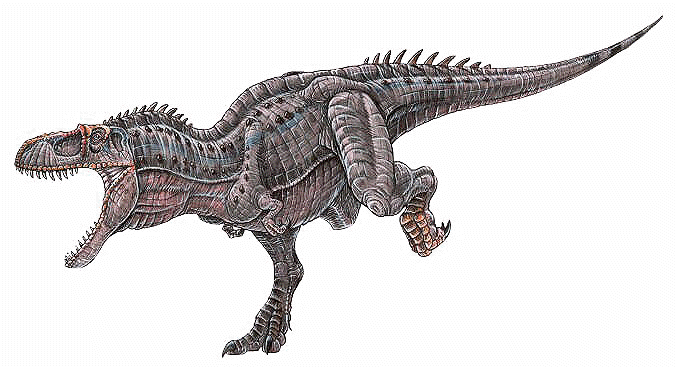|
|
|
Albertosaurus sarcophagus (Osborn, 1905) |
 |
|
Name Means: |
"Albert's Lizard" |
Length: |
30 feet (9 m) |
|
Pronounced: |
al-BURR-to-SORE-us |
Weight: |
3 tons |
|
When it lived: |
Late Cretaceous period, about 76-74
million years ago. |
|
|
|
Where found: |
Alberta, Canada |
|
|
|
|
Introduction |
|
Fierce, meat-eating Albertosaurus sarcophagus is almost identical to its cousin
Tyrannosaurus rex, but not as large. Like other tyrannosaurs, it walked on two legs and had a large
head. It had two-fingered hands on short arms. Its long tail
provided balance and quick turning. It had powerful back legs with
clawed, three-toed feet. The lower jaw of Albertosaurus had from 14
and 16 teeth; the upper jaw had 17-19 teeth. It had one row of teeth
in each jaw but had at least one replacement tooth growing up from
under each tooth. |
|
Discovery |
|
Albertosaurus bones
were among the earliest dinosaur remains collected in Alberta, Canada.
A partial skull was found
by J.B. Tyrrell in 1884 was the first important dinosaur fossil to be
discovered along the Red Deer River. It was named Albertosaurus
sarcophagusin in 1905, the same year that Alberta became a province.
It is the type species of
the genera. For many years
there was only skull material and only one reasonably complete
skeleton. This is unusual as there have been at least one or two
complete skulls found for all other North American tyrannosaurs. |
|
Royal Tyrell Museum |
Joseph Burr Tyrrell was not a
paleontologist. He was a geologist who explored much of western
Canada during the late 1800s and early 1900s. He claimed no
priority in the discovery of dinosaurs in the Red Deer River Valley.
And yet, it is his name that is attached to the premier
paleontological museum in North America -- the one with a major focus
on Red Deer Valley dinosaurs -- the Royal Tyrrell Museum of
Palaeontology in Drumheller.
The exact location of the bonebed discovered by Tyrell has been
lost for many years. But Dr. Philip Currie, paleontologist of
the Royal Tyrell Museum recently found nine Albertosaurus sarcophagus fossils together. Since
these dinosaurs were of different ages, they were probably from a
herd/pack that lived together (at least temporarily). The idea of a
pack of these enormous predators hunting together is extremely scary. The
smallest documented Albertosaurus, a juvenile less than a quarter of
the size of a full grown adult, was collected from Sandy Point on the
South Saskatchewan River in 1986. |
|
Species |
There are two species of Albertosaurus
Albertosaurus sarcophagus
Described above. Stripped of the remains assigned to Gorgosaurus, this
taxon was known mainly from two partial skulls and skeletons.
Recently found
bone bed material will add 9 individuals
in three general size classes.
Albertosaurus arctunguis (Parks, 1928).
Skull length : up to 1 m.; Total length : 8 m.; Hip height : 2.5 m.;
Weight : 2 ton
Albertosaurus libratus (Lambe, 1914) is today known as the
Gorgosaurus libratus. (listed at left). This change of genera is advocated by
many paleontologists, who claim that there are enough differences
between A. libratus and the other Albertosaurus species
to resurrect the older genus name of
Gorgosaurus. Skull length : up to 1 m.; Total length : 8.6 m.;
Hip height : 2.8 m; Weight : 2.5 tonnes |
|
|
|
|
|
|
|
|
Edugraphics.Net | Feenixx Publishing |
|
|
|
|
